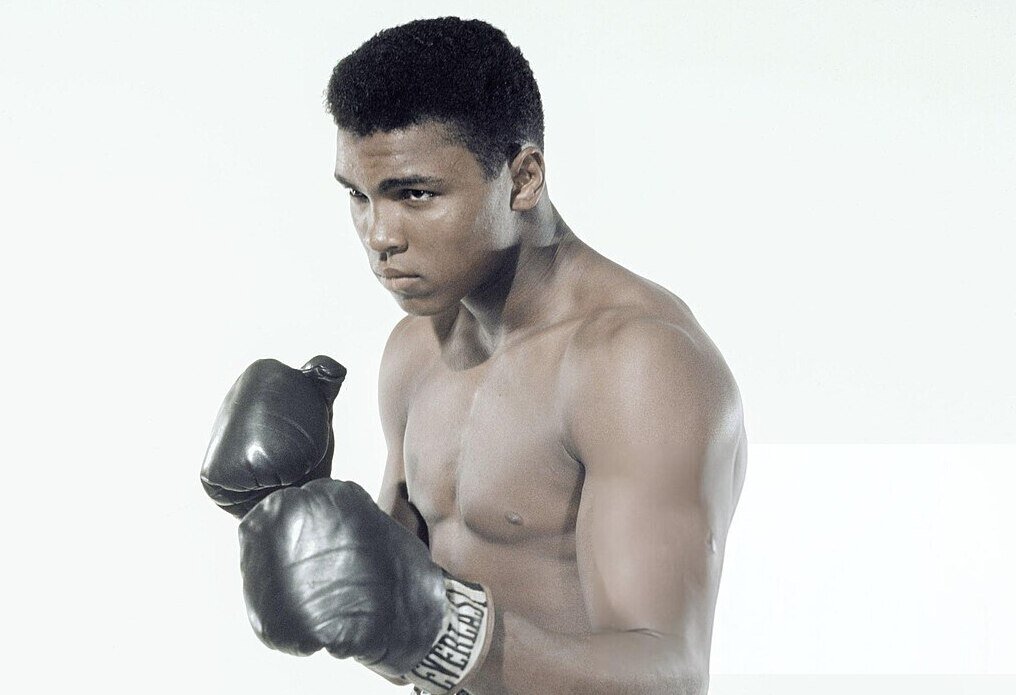The kaleidoscope of his career highlights, spanning from amateur to professional ranks, is mind-boggling. Profound, astonishing, and inspiring moments are plentiful. Yet, for 30 seconds, on an autumn evening in NYC, Muhammad Ali–albeit well beyond his prime–was never better in the clutch.
‘THE [PEOPLE’S] CHAMP’ IS HERE!
A perfectly timed burglary occurred on the night of Ali-Frazier I, a.k.a. “The Fight of the Century” (March 1971). Members of the “Citizens Committee to Investigate the FBI” carried out the investigation. No suspects were ever apprehended, and in a sense, the utilization of Ali’s popularity (and that he was a conscientious objector to the Vietnam conflict) was a stroke of genius in pulling off the heist. The target site was the FBI building in Media, Pennsylvania (adjacent to Philadelphia).
“There was some poetic justice in Ali providing cover for the burglary. As more and more secret FBI files became public as a result of the break-in, it was revealed that the FBI had kept tabs on Ali, beginning with its investigation of his Selective Service case. Some of his phone conversations were tapped, and FBI informers gained access to, of all things, his elementary school records in Louisville (teachers said little Cassius Clay, his original name, loved art). Informers also had diligently monitored and typed, word for word, what Ali said on his appearances on the Tonight Show with Johnny Carson.” [1]
The exposé jarred the Bureau, bringing to light many of their dubious, at times deadly, machinations. Several years later, in 2014, most of the participants in the break-in revealed their identities in interviews.
“[After the incident] when FBI agents interviewed people who lived on the floors above the office, some said they heard nothing because they were listening to the [Ali-Frazier] fight. The distraction of the fight helped the burglars, who called themselves the Citizens Committee, walk away with more than 1,000 documents, including one that revealed the FBI’s secret COINTELPRO operations. These operations involved a panoply of dirty tricks that ranged from planting disinformation about antiwar activists, to planning the murder of a member of the Black Panthers, and sending innocent people to prison based on false testimony by agents and informers.” [1]
Much to the chagrin of FBI Director J. Edgar Hoover (who covertly viewed Clay/Ali as next-to-untouchable), President Nixon, and the majority of the United States establishment, Ali was incrementally becoming “The People’s Champion.”
Within his chosen profession, monumental conquests had accentuated the Muhammad Ali mystique. His inconceivable knockout of the previously undefeated George Foreman (1974), in tandem with his expo of stamina and intrepidness in prevailing over Joe Frazier (1975), intrinsically made the champion one-of-one. He lorded over the heavyweight division, albeit at times by the slimmest of margins, for the mid to latter half of the decade. By 1976, with Ali broaching, but not ardently pondering retirement, his management scrupulously cherry-picked prospective foes.
The gist of it: at rest or in motion, “The Champ,” knowingly or unknowingly, positively influenced the greater good. He did so brazenly, defiantly, without hesitating for anyone’s consent to proceed.
DO ME A FAVOR, GEORGE
Ali v. Norton? The counterparts dueled a total of 39 rounds over three matchups. Each bout went the distance (12, 12, and 15 rounds). Neither sniffed the canvas as most blows stung more than staggered. However, the ironclad Norton had broken Ali’s jaw in the first fight, en route to a colossal upset 12-round decision in front of the former’s frenzied home crowd in San Diego (March 1973).
In the aftermath, Muhammad received a terse, anonymous memorandum amongst his sporadic heap of hate mail, which he never disregarded. It read:
“The butterfly has lost its wings. The bee has lost its sting.”
More captivated than chargrinned, Muhammad harnessed this malevolent prose as a catalyst, and months later—after healing and grueling training sessions (unlike in their opening encounter)—defeated Norton via split decision in Los Angeles (September 1973).
The third meeting, for Ali’s world championship, took place in Yankee Stadium (1976) in what was considered one of the most queried boxing verdicts of all time. The 34-year-old Ali won a unanimous decision. Most ringside sports writers expressed that the challenger, Norton, deserved the nod. In actuality, the official score cards were practically even going into the final round. Norton, concluding that he was in the lead, was beseeched by his cornerman to coast. The champion’s corner implored Ali to go full tilt. Although both men fought in earnest, in the end, the belt still belonged to “The Greatest.”
Veteran ref Arthur Mercante, who also scored the fight, stated, “Against Norton, it came down to the last round. And before the round, I went to both corners like I always do. Angelo Dundee was telling Ali, ‘You’ve got three more minutes. Fight like hell; we need this round.’ And then, in Norton’s corner, I heard his manager, Bob Biron, tell him, ‘Be careful. Stay away from him. Don’t take any chances, because you have the fight won.’ And I said to myself, ‘Gee, that’s not such good advice, to tell Norton to coast. This fight is close.’ But Norton did coast. He gave away the first 2 1/2 minutes of the last round to Ali. And even though he came on strong in the last 30 seconds, it wasn’t enough. Ali won the round.” [2]
A rival, and damn near a nemesis, Ken Norton was a problem. Although Ali had defeated the Herculean challenger twice in the three meetings, the latter bouts were particularly close/controversial decisions. The post-fight pundits were out in full force, scrutinizing the official conclusion.
“Ali’s jabs landed softly. He never shook Norton, never cut him, never slowed him through 15 unexciting rounds. Norton landed 286 punches to Ali, 199, including 192 power punches to Ali, 128. Numbers don’t measure pain. They don’t measure damage. But in this case, the numbers told the story pretty well. Norton was the better and stronger fighter. He landed more punches, a higher percentage of punches, and harder punches.“[3]
At the sound of the bell ending the fight, Ken taunted Ali, yelling, “I beat you!”
Minutes later, as the ring announcer read the scorecards, Norton went from supremely confident to disconsolate as the crowd received the news. All three judges had scored in Ali‘s favor. A confluence of boos and cheers (relief) rained down over the “Bronx Zoo.” Thoroughly aggrieved, the challenger exited the venue awash in tears.
For Ali, Ken Norton remained the enigma he could not decipher. Although victorious in their last two bouts, the Louisville native found Norton difficult to tag, due to his crab-like peekaboo defense. Additionally, the former Marine could deliver a powerful punch and was always in optimal physical condition. Many in the press and the Norton camp were clamoring for a rematch, along with a protest in mind. The champion had other ideas. He campaigned for recently retired George Foreman to fight Norton. Ali then stated that he would fight the winner of that clash.
Far from friends at that point, the Champ called Foreman at home. After showering him with platitudes, Ali popped the question.
George recalled the conversation vividly, years ago. “I do not know how he got my number. He called and complimented me for about 20 minutes, then said, ‘George, would you do me a favor?’ I said, ‘Certainly.’ He said, ‘Please come back and beat Ken Norton and fight him for me. I can’t beat him. George, you can; he’s afraid of you. I’ll let you use my [Deer Lake, Pennsylvania] training camp and everything, but please come back and beat him for me.’” [4] Foreman declined.
During his reign as heavyweight champion, George was widely regarded as a monster. He won the title by massacring the unbeaten Frazier, knocking him down six times in two rounds in Kingston, Jamaica (January 1973). In his first defense, the Houston native pummeled Jose “King” Roman to the floor in the opening round in Tokyo, Japan (September 1973). He then defended the crown against an up-and-coming Ken Norton in Caracas, Venezuela (March 1974). George demolished Ken in two rounds with a savage knockout, bringing his record to 40-0. Ali got his opportunity to go against George later that year and stunned the entire planet by wearing the behemoth George down, utilizing the rope-a-dope, and then knocking him out in the eighth round.
IN DIFFERENT AREA CODES
Ali was incredibly able to compete at such a prominent echelon during this juncture in his career. The champion and humanitarian, who had surmounted the United States Armed Forces, a potential conviction (winning a Supreme Court decision 8-0, although he would likely lose 6-3 today), and several state boxing commissions, was a patron saint to legions, but still loathed by more than a bantam-like throng of individuals who considered him an “arrogant, loud-mouthed, draft-dodger.”
One constant issue he battled outside the ring was his insatiable appetite for the ladies. By the mid-70s, the champ was on his second marriage (Belinda Boyd), but it was hanging by a thread. Ali’s good looks and celebrity status made him a magnet for gorgeous women, and he was happy to oblige them.
“Among friends, Ali would joke about his infidelities, stating: ‘My wife is married.’ Black women, white women, young women, older women, Hollywood actresses,
chambermaids: Ali didn’t discriminate. Everyone close to the fighter knew his life. His friends laughed about it, his entourage members and business associates supported it.“ [3]
According to longtime confidante Leon Muhammad of the Philadelphia mosque, “Ali‘s weakness was ‘Coochie,’” he continued. “Ali did a lot of things because he was Ali. People would say to him, ‘Hey, be loyal to Belinda.’ How can you tell a guy that when he’s the boss, when he’s paying you?” [3]
While members of his ever-expanding posse commonly shouldered the culpability for his shortcomings, Muhammad was his own man. Eventual world champion Larry Holmes was his sparring partner for several years before he embarked on his professional career. Holmes loved Ali like a big brother! However, Larry was loyal to his wife, Diane, and learned from the champion and the rest of the training camp members and hangers-on what not to do. According to Holmes, “I knew how [Ali] lived. I knew what he did. I saw the people come into camp and leave camp. I know he walked around with a stiff d**k every day. I watched, I took it all in. I said, ‘That ain’t gonna happen to me. I ain’t gonna do like this. I ain’t going to do like that.’ And I didn’t do it like that. I was careful.” [5]
Before losses to both Joe Frazier in 1971 and Ken Norton in 1973, Ali, allegedly, had sex with prostitutes within a few hours of each match! In both instances, his wife nabbed him. Before the bout with Frazier, Ali, using the hotel room of a member of his staff, paid $40 for his pre-fight tryst, then attempted to hide her in the shower after an enraged Belinda showed up, pounding on his door. Two years later, a mere two hours before squaring off with Norton, again using the room of a member of the entourage, the “Louisville Lothario” was in bed with two sex workers. “They took the mirror off the dresser and propped it next to the bed so that they could watch themselves. After an hour had passed, [a confidante] knocked on the door, telling Ali that the fight would start soon.” [3]
Ali’s response: “Oh shit! I gotta take a shower.” [3]


